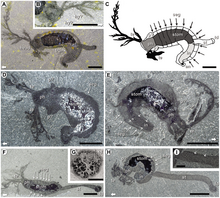ZIC3
ZIC3는 소뇌([5][6]ZIC) 단백질 패밀리의 아연 손가락의 구성원이다.
ZIC3는 5개의 C2H2 아연 손가락의 보존으로 인해 ZIC 단백질로 분류되며, 이는 단백질이 DNA 및 단백질과 상호작용할 수 있게 해준다.초기 발육에 중요한 단백질 패밀리의 정확한 기능, 그리고 이러한 단백질을 코드하는 유전자의 돌연변이가 다양한 선천적 결함을 초래하는 것으로 알려져 있다.예를 들어, ZIC3의 돌연변이는 초기 좌우 대칭 형성에 있어 ZIC3의 역할로 인해 발생하는 것으로 생각되는 헤테로 [7][8]은하와 관련되며, 이는 초기 배아의 비대칭성이 [9]깨진 후 재분포된 노달의 유지를 수반한다.ZIC3의 돌연변이는 또한 심장 루프와 같은 다양한 심장 결함과 관련이 있지만, 이것들은 가벼운 형태의 이형성인 것으로 생각된다.마우스 기반 연구는 결함이 있는 ZIC3를 신경관 결함(척추 이피다 및 외뇌증) 및 골격 결함과 연결했으며 신경 파고 사양에서 Zic3의 역할을 나타냈다.[11] Zic3의 손실로 인한 좌우 결함 및 신경관 결함 모두 평면 세포 극성 결함으로 연결되었습니다.[12]
ZIC3는 배아줄기세포의 다능성을 [13]유지하기 위해 필요한 것으로 알려져 있어 특별한 관심을 끌고 있다.
Wnt 시그널링에 대한 관여
ZIC 패밀리의 또 다른 멤버인 ZIC2는 TCF7L2와 상호작용하는 것으로 최근 밝혀져 Wnt/β-카테닌 신호전달 [14]억제제 역할을 할 수 있다.추가 실험에 따르면 인간 ZIC3는 Wnt 신호 전달을 억제할 수 있으며 아연 핑거 도메인은 이 [15]역할에 절대적으로 중요하다.그러한 역할은 중요한데, 정확한 Wnt 시그널링이 초기 [16]발병에 매우 중요할 뿐만 아니라 Wnt 시그널링이 여러 암에 대해 상향 조절되는 것으로 밝혀졌다.또한 표준 Wnt의 Zic3 억제는 최근 [17]생쥐의 신경능 특이성에 역할을 하는 것으로 나타났다.
레퍼런스
- ^ a b c GRCh38: 앙상블 릴리즈 89: ENSG00000156925 - 앙상블, 2017년 5월
- ^ a b c GRCm38: 앙상블 릴리즈 89: ENSMUSG000067860 - 앙상블, 2017년 5월
- ^ "Human PubMed Reference:". National Center for Biotechnology Information, U.S. National Library of Medicine.
- ^ "Mouse PubMed Reference:". National Center for Biotechnology Information, U.S. National Library of Medicine.
- ^ Ali RG, Bellchambers HM, Arkell RM (November 2012). "Zinc fingers of the cerebellum (Zic): transcription factors and co-factors". The International Journal of Biochemistry & Cell Biology. 44 (11): 2065–2068. doi:10.1016/j.biocel.2012.08.012. PMID 22964024.
- ^ "Entrez Gene: ZIC3 Zic family member 3 heterotaxy 1 (odd-paired homolog, Drosophila)".
- ^ Ware SM, Peng J, Zhu L, Fernbach S, Colicos S, Casey B, et al. (January 2004). "Identification and functional analysis of ZIC3 mutations in heterotaxy and related congenital heart defects". American Journal of Human Genetics. 74 (1): 93–105. doi:10.1086/380998. PMC 1181916. PMID 14681828.
- ^ Bellchambers HM, Ware SM (2018). "ZIC3 in Heterotaxy". Advances in Experimental Medicine and Biology. 1046: 301–327. doi:10.1007/978-981-10-7311-3_15. PMID 29442328.
- ^ Ware SM, Harutyunyan KG, Belmont JW (June 2006). "Heart defects in X-linked heterotaxy: evidence for a genetic interaction of Zic3 with the nodal signaling pathway". Developmental Dynamics. 235 (6): 1631–1637. doi:10.1002/dvdy.20719. PMID 16496285.
- ^ Purandare SM, Ware SM, Kwan KM, Gebbia M, Bassi MT, Deng JM, et al. (May 2002). "A complex syndrome of left-right axis, central nervous system and axial skeleton defects in Zic3 mutant mice". Development. 129 (9): 2293–2302. PMID 11959836.
- ^ Bellchambers HM, Barratt KS, Diamand KE, Arkell RM (September 2021). "SUMOylation Potentiates ZIC Protein Activity to Influence Murine Neural Crest Cell Specification". International Journal of Molecular Sciences. 22 (19): 10437. doi:10.3390/ijms221910437. PMC 8509024. PMID 34638777.
- ^ Bellchambers HM, Ware SM (November 2021). "Loss of Zic3 impairs planar cell polarity leading to abnormal left-right signaling, heart defects and neural tube defects". Human Molecular Genetics. 30 (24): 2402–2415. doi:10.1093/hmg/ddab195. PMID 34274973.
- ^ Lim LS, Hong FH, Kunarso G, Stanton LW (November 2010). "The pluripotency regulator Zic3 is a direct activator of the Nanog promoter in ESCs". Stem Cells. 28 (11): 1961–1969. doi:10.1002/stem.527. PMID 20872845.
- ^ Pourebrahim R, Houtmeyers R, Ghogomu S, Janssens S, Thelie A, Tran HT, et al. (October 2011). "Transcription factor Zic2 inhibits Wnt/β-catenin protein signaling". The Journal of Biological Chemistry. 286 (43): 37732–37740. doi:10.1074/jbc.M111.242826. PMC 3199516. PMID 21908606.
- ^ Ahmed JN, Ali RG, Warr N, Wilson HM, Bellchambers HM, Barratt KS, et al. (May 2013). "A murine Zic3 transcript with a premature termination codon evades nonsense-mediated decay during axis formation". Disease Models & Mechanisms. 6 (3): 755–767. doi:10.1242/dmm.011668. PMC 3634658. PMID 23471918.
- ^ Fossat N, Jones V, Khoo PL, Bogani D, Hardy A, Steiner K, et al. (February 2011). "Stringent requirement of a proper level of canonical WNT signalling activity for head formation in mouse embryo". Development. 138 (4): 667–676. doi:10.1242/dev.052803. PMID 21228006.
- ^ Bellchambers HM, Barratt KS, Diamand KE, Arkell RM (September 2021). "SUMOylation Potentiates ZIC Protein Activity to Influence Murine Neural Crest Cell Specification". International Journal of Molecular Sciences. 22 (19): 10437. doi:10.3390/ijms221910437. PMC 8509024. PMID 34638777.
추가 정보
- Bellchambers HM, Ware SM (2018). "ZIC3 in Heterotaxy". Advances in Experimental Medicine and Biology. 1046: 301–327. doi:10.1007/978-981-10-7311-3_15. PMC 8445495. PMID 29442328.
- Houtmeyers R, Souopgui J, Tejpar S, Arkell R (October 2013). "The ZIC gene family encodes multi-functional proteins essential for patterning and morphogenesis". Cellular and Molecular Life Sciences. 70 (20): 3791–3811. doi:10.1007/s00018-013-1285-5. hdl:1885/65873. PMID 23443491.
- Bedard JE, Purnell JD, Ware SM (January 2007). "Nuclear import and export signals are essential for proper cellular trafficking and function of ZIC3". Human Molecular Genetics. 16 (2): 187–198. doi:10.1093/hmg/ddl461. PMID 17185387.
- Zhu L, Harutyunyan KG, Peng JL, Wang J, Schwartz RJ, Belmont JW (July 2007). "Identification of a novel role of ZIC3 in regulating cardiac development". Human Molecular Genetics. 16 (14): 1649–1660. doi:10.1093/hmg/ddm106. PMID 17468179.








